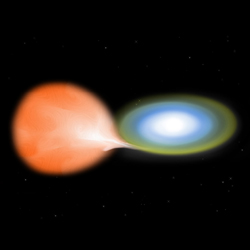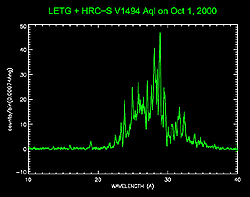September 6, 2001
CXC PR: 01-11
NASA's Chandra X-ray Observatory has discovered a giant outburst of X-rays and unusual cyclical pulsing from a white dwarf star that is closely orbiting another star -- the first time either of these phenomena has been seen in X-rays. The observations are helping scientists better understand the thermonuclear explosions that occur in certain binary star systems.
The observations of Nova Aquilae were reported today at the "Two Years of Science with Chandra" symposium by an international team led by Sumner Starrfield of Arizona State University.
"We found two important results in our Chandra observations. The first was an underlying pulsation every 40 minutes in the X-ray brightness, which we believe comes from the cyclical expansion and contraction of the outer layers of the white dwarf," said Starrfield. "The other result was an enormous flare of X-rays that lasted for 15 minutes. Nothing like this has been seen before from a nova, and we don't know how to explain it."
Novas occur on a white dwarf (a star which used up all its nuclear fuel and shrank to roughly the size of the Earth) that is orbiting a normal size star. Strong gravity tides drag hydrogen gas off the normal star and onto the white dwarf, where it can take more than 100,000 years for enough hydrogen to accumulate to ignite nuclear fusion reactions. Gradually, these reactions intensify until a cosmic-sized hydrogen bomb blast results. The outer layers of the white dwarf are then blown away, producing a nova outburst that can be observed for a period of months to years as the material expands into space.
"Chandra has allowed us to see deep into the gases ejected by this giant explosion and extract unparalleled information on the evolution of the white dwarf whose surface is exploding," said Jeremy Drake of the Harvard-Smithsonian Center for Astrophysics.
The brightening of Nova Aquilae was first detected by optical astronomers in December 1999. "Although this star is at a distance of more than 6,000 light years, it could be seen with the naked eye for about a month, during which it was about 100,000 times brighter than our own Sun," said R. Mark Wagner of the University of Arizona.
Chandra observed the nova, so-called because early astronomers believed they heralded the appearance of a new star, four times from April 2000 through October 2000. "Our first Chandra observations showed that the expanding gas around Nova Aquilae was hot and nearly opaque," said Joachim Krautter of the State Observatory in Heidelberg, Germany. "When we looked months later with Chandra, the expanding gases cleared enough for us to see through them to the underlying star on which the explosion occurred."
The latter Chandra X-ray data revealed the cyclical changes in brightness are due to the white dwarf expanding and shrinking over a 40-minute period. They also showed that the temperature on the surface of the white dwarf was 300,000 degrees Celsius, making Nova Aquilae one of the hottest stars ever observed to undergo such pulsations.
"The observations told us that thermonuclear fusion reactions were still occurring on the surface layers of the white dwarf – more than eight months after the explosion first began!" said Robert Gehrz of the University of Minnesota.
Other members of the team are Howard Bond (Space Telescope Science Institute), Yousaf Butt (Harvard-Smithsonian Center for Astrophysics), Koji Mukai (Goddard Space Flight Center), Peter Hauschildt (University of Georgia), Margarida Hernanz (Institute for Space Studies, Catalonia, Spain), Marina Orio (University of Wisconsin and the Torino Observatory in Italy), and Charles Woodward (University of Minnesota).
Chandra observed Nova Aquilae for a total of 10 hours with the High Resolution Camera (HRC) and the Advanced CCD Imaging Spectrometer (ACIS). The HRC was built for NASA by the Smithsonian Astrophysical Observatory, Cambridge, MA. The ACIS instrument was built for NASA by the Massachusetts Institute of Technology, Cambridge, and Pennsylvania State University, University Park. NASA's Marshall Space Flight Center in Huntsville, Ala., manages the Chandra program. TRW, Inc., Redondo Beach, Calif., is the prime contractor for the spacecraft. The Smithsonian's Chandra X-ray Center controls science and flight operations from Cambridge, Mass.
Images associated with this release are available on the World Wide Web at:
MEDIA CONTACTS
Steve Roy
Marshall Space Flight Center, Huntsville, AL
Phone: 256-544-6535
Megan Watzke
Chandra X-ray Observatory Center, CfA, Cambridge, MA
Phone: 617-496-7998




